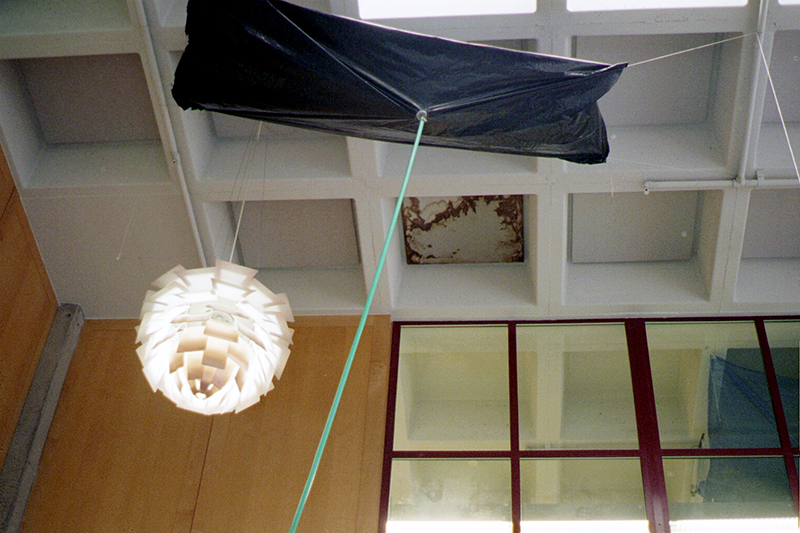Conventional Wisdom
What is The Cost Effective Method?
How Does it Work?
How to Do it?
| Action | Remarks |
| I) Materials Required |
|
| a) 20kg Nylon fishing String or Nylon Twine |
|
| b) 0.1mm (100 micron) thick plastic bag of size capable of covering the leakage area to form a “drain”; the alternate is to use tarpaulin sheet. Transparent sheet is preferred as one can spot water pool forming. A plastic covering sheet such as those used for house painting job can be as a canvas to cover an area as big as 9' x 12' as shown.
| |
| c) 4 pieces of wall hooks for wooden walls or special hooks for masonry walls. |
|
| d) Fabric sheets |
|
| e) Stapler, ladder and tools | |
| II) Preparation
|
|
| 1. Survey the location and the area of the leak | |
| 2, Determine where the water would be drained and the slope for forming the “drain” | |
| 3. If big plastic bags are used, cut and split both edge of the plastic bag to form a continuous sheet. Spread the sheet over the floor. | |
| 4. Cut multiple strips of about 12 mm width from the fabric sheet; either tie or join the strips with plastic sealer or electric iron or just using stapler to form continuous length of “wick” to direct the water More strips can be used as wicks if water draining is not fast enough. | |
| III) Installation
|
|
| 1. Install the 4 hooks at four corners; for a large area, more hooks might be required and can be fixed after the installation; 2. Run the nylon fishing string to the 4 corners and tie a knot so that the string can be hooked or unhooked from the hook, making sure there is no slag in the string;
8. Cut a small hole underneath for the pool of water to be drained out. | |
| IV) Improving Water Flow |
|
| 1. Make a long wick using the fabric sheet as described in step 1(d) and place the long water wick through the small hole. If needed be, tie the wick be tied to a “stopper” made from plastic sheets/bag to stop the wick from sliding through the small hole. Spread the top end of the wick to direct water to be drain out through the hole so that there will not be any water pool on the canvas. Remember: water pool will add weights to the canvas
2. Place more wicks to hang from the ceiling so as to direct the water down to plastic sheet or tarpaulin. “nail” or staple the wicks to secure it onto the ceiling or false ceiling. Extend the wick if necessary by stapling them. | Without the water wicks, water would splash over the place when it hit the water surface This will ensure water will be "drained" quickly from the ceiling. |
| V) Testing and Commission |
|
| 1. Check that water will drip into the pail provided
| If the wicks have been installed correctly, there shall not be any water pool found in the plastic sheet or tarpaulin and hence, no additional weight would be added. Cheaper and thinner plastic sheets can be used as canvas |
Update 8 November 2018
What Best to do if the leaks spread Further?
The traditional wisdom is to enlarge the canvas or put up another canvas to cover the new leaking area; however, the leak might just be temporary as it find its way to other locations. This is because water will always find a path with the least resistance. The existing water path could be clogged up with "debris"; water will find new path to flow.
The better method is still using strips of fabric cloth. Cut to size and join them up either by plastic bag sealer or stapler to form longer strip. Because the fabric are woven material that has good capillary action to "suck up' or lift water to higher level, it can be used to direct the water drippings to where one would like them to flow. In this example, water drippings were directed to flow from the study room next door through the top of a door to the bucket of water placed in the bed room as shown in the following pictures
(dbclick to enlarge pictures)
Other Interesting Methods
(Dbclick to enlarge pictures)
_________________________________________________________________________________
tinyurl : https://tinyurl.com/y9egku8q



























I truly like to read your post. Thank you so much for taking the time to share such nice information.
ReplyDeleteElsa Water Leakage
Great post, keep posting. Protect your ceilings and way to handle water leaking ceilings.To cover the top area of the building Roofing Sheets in Chennai are preferred. It protects from the heavy temperature. Roofing Sheet Prices in Chennai will afford you the best price. It includes some materials and construction things to support the building walls.
ReplyDeleteHighly beneficial information particularly the last part. I take care of this kind of information much. I was seeking this specific information for a long time. Thanks and good luck.
ReplyDeleteTarpaulin Suppliers In India
Nice blog, thanks for sharing this roof repair post with us. Keep sharing more informative posts like this.
ReplyDeletecost of waterproofing roof Singapore